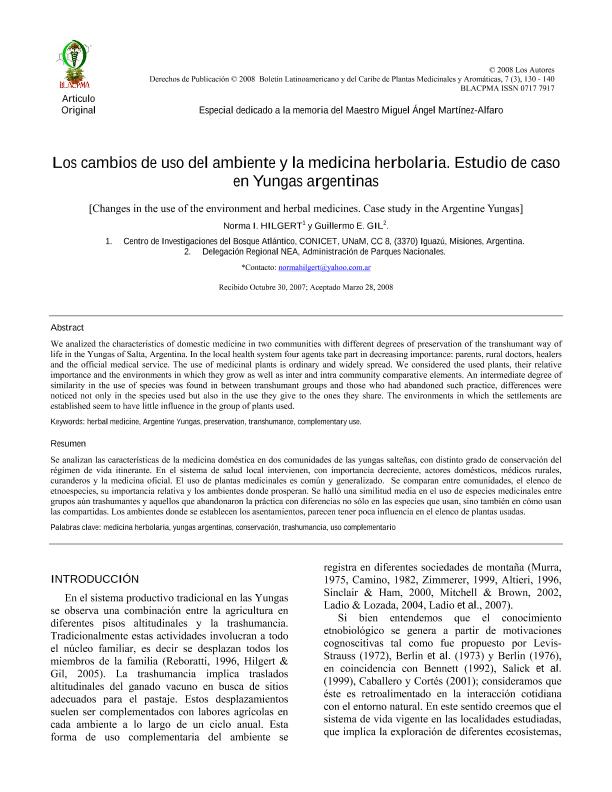Mostrar el registro sencillo del ítem
dc.contributor.author
Hilgert, Norma Ines

dc.contributor.author
Gil, Guillermo E.
dc.date.available
2018-09-18T22:27:24Z
dc.date.issued
2008-05
dc.identifier.citation
Hilgert, Norma Ines; Gil, Guillermo E.; Los cambios de uso del ambiente y la medicina herbolaria. Estudio de caso en Yungas argentinas; Cooperación Latinoamericana y Caribeña en Plantas Medicinales y Aromáticas; Boletin Latinoamericano y del Carible de Plantas Medicinales y Aromáticas; 7; 3; 5-2008; 130-140
dc.identifier.issn
0717 7917
dc.identifier.uri
http://hdl.handle.net/11336/60199
dc.description.abstract
We analized the characteristics of domestic medicine in two communities with different degrees of preservation of the transhumant way of life in the Yungas of Salta, Argentina. In the local health system four agents take part in decreasing importance: parents, rural doctors, healers and the official medical service. The use of medicinal plants is ordinary and widely spread. We considered the used plants, their relative importance and the environments in which they grow as well as inter and intra community comparative elements. An intermediate degree of similarity in the use of species was found in between transhumant groups and those who had abandoned such practice, differences were noticed not only in the species used but also in the use they give to the ones they share. The environments in which the settlements are established seem to have little influence in the group of plants used.
dc.description.abstract
Se analizan las características de la medicina doméstica en dos comunidades de las yungas salteñas, con distinto grado de conservación del régimen de vida itinerante. En el sistema de salud local intervienen, con importancia decreciente, actores domésticos, médicos rurales, curanderos y la medicina oficial. El uso de plantas medicinales es común y generalizado. Se comparan entre comunidades, el elenco de etnoespecies, su importancia relativa y los ambientes donde prosperan. Se halló una similitud media en el uso de especies medicinales entre grupos aún trashumantes y aquellos que abandonaron la práctica con diferencias no sólo en las especies que usan, sino también en cómo usan las compartidas. Los ambientes donde se establecen los asentamientos, parecen tener poca influencia en el elenco de plantas usadas.
dc.format
application/pdf
dc.language.iso
spa
dc.publisher
Cooperación Latinoamericana y Caribeña en Plantas Medicinales y Aromáticas
dc.rights
info:eu-repo/semantics/openAccess
dc.rights.uri
https://creativecommons.org/licenses/by-nc-sa/2.5/ar/
dc.subject
Medicina Herbolaria
dc.subject
Yungas Argentinas
dc.subject
Consrvación
dc.subject
Trashumancia
dc.subject
Uso Complementario
dc.subject.classification
Otras Ciencias Biológicas

dc.subject.classification
Ciencias Biológicas

dc.subject.classification
CIENCIAS NATURALES Y EXACTAS

dc.title
Los cambios de uso del ambiente y la medicina herbolaria. Estudio de caso en Yungas argentinas
dc.title
Changes in the use of the environment and herbal medicines. Case study in the Argentine Yungas
dc.type
info:eu-repo/semantics/article
dc.type
info:ar-repo/semantics/artículo
dc.type
info:eu-repo/semantics/publishedVersion
dc.date.updated
2018-09-12T17:29:45Z
dc.journal.volume
7
dc.journal.number
3
dc.journal.pagination
130-140
dc.journal.pais
Chile

dc.journal.ciudad
Santiago de Chile
dc.description.fil
Fil: Hilgert, Norma Ines. Centro de Investigaciones del Bosque Atlántico; Argentina. Universidad Nacional de Misiones; Argentina. Consejo Nacional de Investigaciones Científicas y Técnicas. Centro Científico Tecnológico Conicet - Nordeste; Argentina
dc.description.fil
Fil: Gil, Guillermo E.. Administración de Parques Nacionales. Delegación Regional Nordeste Argentino; Argentina
dc.journal.title
Boletin Latinoamericano y del Carible de Plantas Medicinales y Aromáticas
dc.relation.alternativeid
info:eu-repo/semantics/altIdentifier/url/http://www.redalyc.org/articulo.oa?id=85670303
Archivos asociados
